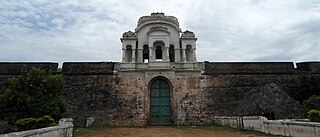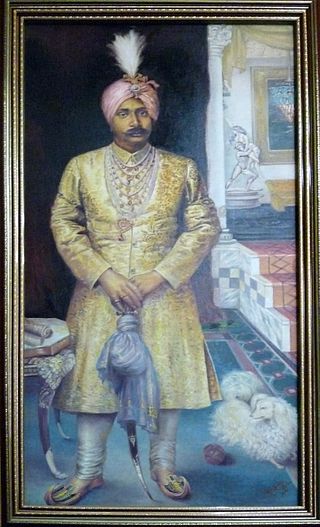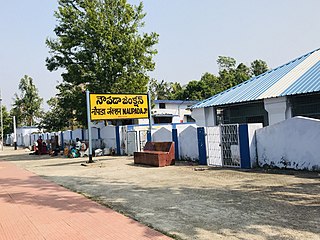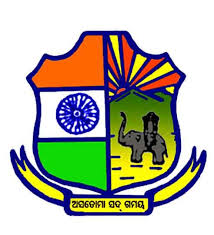
Rayagada district is a district in southern Odisha, a state in India, which became a separate district in October 1992. Its population consists mainly of tribes, primarily the Khonds and the Soras. In addition to Odia, Kui and Sora are spoken by the district's indigenous population. It was founded by Maharajah Biswanatha Deba Gajapati of the Surjyabansha dynasty of Jeypore.

Gajapati district is a district of Odisha State in India. It was created from Ganjam District on 2 October, 1992. As of 2011 it is the third least populous district of Odisha, after Debagarh and Boudh. The District is a part of the Red Corridor.

Paralakhemundi shortly known as Parala is district Headquarter of Gajapati district and one of the oldest Municipality established in 1885, in the Indian state of Odisha. Majority of the people in the town speak Odia. The city and the District share its boundaries with Andhra Pradesh. The adjacent town of Pathpatnam is separated by the River Mahendra Tanaya.In later medieval period it became capital of Paralakhemundi Estate of Eastern Ganga dynasty kings of Khemundi Branch. The town is well known for being an ancient cultural center of Odisha and birthplace of noted personalities including poet Gopalakrusna Pattanayaka, statesman Krushna Chandra Gajapati Narayan Deo, lexicographer Gopinatha Nanda Sharma and historian Satyanarayana Rajguru. This town is also known for its century old temples, monasteries, palaces and heritage buildings.

Gunupur is a Municipality and one of the sub-divisional headquarters of Rayagada district in the Indian state of Odisha. It is the second biggest town in Rayagada district.

Kashinagar is a town and headquarters of a community development block of the same name in Gajapati district in the Indian state of Odisha.

Pathapatnam is a town in Srikakulam district of the Indian state of Andhra Pradesh. It is located in Pathapatnam mandal of Palakonda revenue division. Pathapatnam is located on the border of Srikakulam district of Andhra Pradesh and Gajapati district of Odisha. Parlakhemundi, the headquarters of Gajapati District, can be considered as twin town of Pathapatnam because of its close proximity. It is located around 65 km from srikakulam. It was the old capital of Paralakhemundi Gajapati Maharajah of his erstwhile kingdom.
Lihuri station is located in Naupada–Gunupur branch line on the Odisha–Andhra border.
Mayurbhanj State Railway (MSR) was a 2 ft 6 in (762 mm) narrow gauge railway owned by Mayurbhanj State in British India.

The name is derived from its founder Raja Vijayaram Raj who established a sovereign kingdom by claiming independence from the Kingdom of Jeypore in 1711. It formed alliances with the French and British East India Company to conquer the neighbouring principalities of Bobbili, Kurupam, Paralakhemundi and the Kingdom of Jeypore. However, they fell out with the British and as a result were attacked and defeated in the Battle of Padmanabham. They were annexed as a tributary estate like other principalities and remained so until their accession to the Indian Union in 1949.

Krushna Chandra Gajapati KCIE, also known as Captain Maharaja Sri Sri Sri Krushna Chandra Gajapati Narayana Deva KCIE, was a key personality and regarded as the architect, founding father of an Independent Odia Language speaking state Odisha. He was a scion of Paralakhemundi Estate and the owner of Delanga estate of Puri district of Odisha. His family belonged to the great Eastern Ganga Dynasty. He was the first Prime Minister of Orissa. The present-day Gajapati District of Odisha was named after him.

Orissa Province was a province of British India created in April 1936 by the partitioning of the Bihar and Orissa Province and adding parts of Madras Presidency and Central Provinces. Its territory corresponds with the modern-day State of Odisha.

Naupada Junction railway station, located in the Indian state of Andhra Pradesh, serves Naupada in Srikakulam district. It is a junction station with a branch line to Gunupur in Rayagada district of Odisha which was built by Maharaja of Paralakhemundi.Former it was known as Parlakimedi Light Railway.
Badagam is a small village in the Rayagada Block and Parlakhemundi municipality in Gajapati district in the Indian state of Odisha. The major languages spoken in this place are Kui and Oriya.
Naupada–Gunupur railway line belongs to East Coast Railway of Waltair division.
Gunupur railway station belongs to East Coast Railway of Waltair division.Maharaja of Paralakhemundi extended Naupada-Paralakhemundi line to Gunupur in 1931 AD. It is located at Gunupur in Rayagada district of Indian state of Odisha. Established by His highness Maharaja Krushna Chandra Gajapati of Paralakhemundi estate.
Paralakhemundi Railway Station belongs to East Coast Railway of Waltair Division. It is located in Gajapati district of Odisha.This is the FIRST ODISHA DEDICATED RAILWAY LINE as well as the FIRST ROYAL RAILWAY STATION of ODISHA, established in 1899. The total section was established by Gajapati Maharaja of Paralakhemundi and it is first odisha Origin Railway station of Odisha state. This line was the FIRST LITE RAIL LINE OF EASTERN INDIA otherwise known as Parlakimedi Light Railway PLR, one of the oldest station in odisha. This is the first Lite Railway station of odisha. After five years, Mayurbhanj State Railway came in to existence. Hence, it was the first Narrow gauge railway station of Odisha.

Shri Krushna Chandra Gajapati Autonomous College is an autonomous college situated in Paralakhemundi in southern Odisha.

Gajapati Palace located at Paralakhemundi, of Gajapati district, Odisha, is the fort of Gajapati rulers where they used to stay. Nowadays the property is under the protection of Indian National Trust for Art and Cultural Heritage (INTACH). The palace is one of the rich architectural and cultural heritage of India. This palace was built for a purpose of permanent residential abode for the Gajapati Rulers of Paralakhemundi Estate belonging to the Eastern Ganga dynasty.

Parlakhemundi estate was a Zamindari of Odisha in the British Raj period .Before odisha province formation it was under Madras Presidency.The state was ruled as an independent kingdom till 1769.The royal family belong to the Krishnatreya gotra Odia Kshatriya and traced their lineage to Eastern Ganga Dynasty.It was a zamindari estate lying in the southwestern portion of Ganjam district, covering an area of 615 square miles. It was bounded in the south by the district of Vizagpatnam and on the west by the Jeypore Estate and the tribal agencies of the Eastern Ghats.











